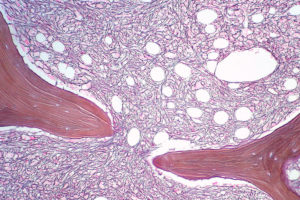You have many stem cell types in your body, and StemCell ARTs would like to educate you about the one that lives in your bone marrow and why it lives there and not somewhere else. We’ll do that through a discussion of fish and frogs. Meet the HSC.
What Are Hematopoietic Stem Cells?
You might not realize that our bones aren’t simply a scaffolding that serves as the body’s supporting framework, they are also one of the human body’s blood cell-producing machines. Hematopoietic stem cells (HSCs) are the cells from which all blood cells (e.g., erythrocytes, lymphocytes, megakaryocytes, neutrophils, macrophages, etc.) are formed. Our circulating blood cells live hard and die fast, which means they must continuously be replaced. This assembly line of blood cell production occurs in humans in the bone marrow inside our bones, with those hematopoietic stem cells producing in excess of hundreds of billions of new blood cells daily, a process known as hematopoiesis (hemato- meaning “blood” and -poiesis meaning “producing” or “forming”).
Today, we’re going to focus on hematopoietic stem cells (HSCs), but it’s also important to differentiate these from mesenchymal stem cells (MSCs), which are also primarily found in the bone marrow. MSCs, however, produce cells that form musculoskeletal tissue, such as bone (osteocytes), muscle (myocytes), and cartilage (chondrocytes) cells. However, HSCs can help repair muscle as they can replace muscle stem cells in time of need.
Interestingly, locations for HSC sources in non-mammals vary, often occurring in organs, such as the kidneys. Let’s explore.
HSC Location Attributed to Ultraviolet Light Protection
Researchers in the new study, using humans as the mammal observation and zebrafish as the non-mammal observation, investigated the zebrafish to determine why HSCs are sourced in the kidneys. The answer was found in melanocytes. In humans, melanocytes are cells that produce a pigment called melanin, which determines the color of our skin, hair, eyes, and so on. In other species, such as fish, snakes, and birds, melanocytes also exist and provide the coloring for scales, feathers, and so on. Researchers determined that a specific pattern of the melanocytes on the zebrafish actually shaded the kidneys, protecting them from ultraviolet light.
Researchers also tested the effect of UV light specifically on the HSCs in the kidneys of the fish (literally by turning the fish upside down in one test and exposing the unshaded underside of the kidney to UV light) and determined that the UV light damages the DNA of the cells. Therefore, the specific coloring design, the “melanocyte umbrella,” over the kidneys of the zebrafish protects the HSCs from damage, making the kidneys an ideal location in this species for HSCs.
Another fascinating facet to the study—researchers also studied the effect of UV light in terrestrial frogs. As tadpoles, HSCs were sourced in the kidneys, which also had the same melanocyte protection described in the zebrafish above. However, as the tadpoles grew legs and transitioned to land-dwelling frogs, the HSCs also transitioned from the kidneys to the bone marrow. This, again, was attributed to the HSC protection that would be necessary from UV light.
The study pointed out that in mammals, an organ, such as the kidney, would not be capable of insulating the HSCs from UV light; however, the bone marrow, well protected by the dense bones, provides the perfect light-free environment for HSCs to thrive and maintain their stringent blood cell-producing schedule.
Problems That Can Occur with Hematopoietic Stem Cells
UV light exposure or not, our HSCs can still become permanently damaged, either due to genetics (inherited mutations) or due to environmental factors (somatic mutations), such as smoking or chemical exposure. These mutations can be passed to replicate cells and can even lead to cancer and other diseases, though our immune cells do a pretty good job of destroying these bad cells. The risk of these somatic mutations, however, does increase with age, and when they occur in our HSCs, our risk of heart disease, stroke, hematologic cancers, and other diseases increases.
The upshot? Understanding the different stem cell types found in your bone marrow is important. In addition, turns out that there’s a reason that these critical repair cells live deep inside thick bone. They’re there to protect themselves and you from the harmful effects of UV and other types of radiation that may mutate these cells. So hopefully you’ll look at your bones a little differently now, as both structure and the key to a long and active life.
Call StemCell ARTs today to learn more about how stem cell obtained from your bone marrow can benefit you.

